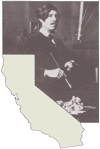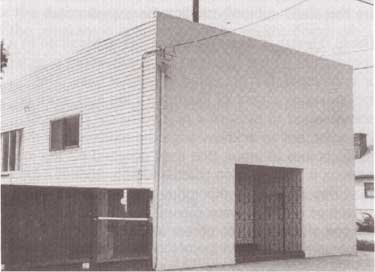![]()

Five Views: An Ethnic Historic Site Survey for California
MENU
Introduction
Mexican War
Post-Conquest
1900-1940
World War II
Chicano Movement
Future
Historic Sites
Selected References

A History of Mexican Americans in California:
HISTORIC SITES
Sociedad Catolica Regional Guadalupana
(Guadalupana Hall)
Richmond, Contra Costa County
The Sociedad Catolica Regional Guadalupana in Richmond, Contra Costa County, is a wood-frame building with a composition roof and a stucco-covered front. The back section has two stories. A meeting hall occupies the entire first floor of the front section, while a kitchen, restroom, and bar are located on the first floor of the back section. The second story houses the society's executive offices. There is a small maintenance shed on the back portion of the lot. A wooden fence encloses the sides and back of the lot.
Historically, Catholicism has been a central institutional force in California's Spanish-speaking communities. The chain of missions and numerous adobe chapels constructed in the eighteenth and nineteenth centuries as part of the settlement of California attests to the significance of Catholicism to Spain's conquest of this region. That the conquest was effected from Mexico and that the colonizers were largely mestizo, however, etched a particular design on the Catholicism that took root in California and the Southwest. Further, the continuous waves of Mexican immigration throughout the twentieth century have served to strengthen the particular design of Mexican Catholicism in Chicano communities throughout California.
Mexican Catholicism revolves around the figure of La Virgen de Guadalupe, also known as the dark-skinned Madonna, the Patroness of Mexico, and the Patron Saint of the Poor. Because she appeared to an impoverished Mexican Indian man, she is considered to be the special protector of Mexico, a nation of Indios and Mestizos, and thus of impoverished, dark-skinned people.
According to Church history, La Virgen de Guadalupe appeared to Juan Diego one cold December 12 in 1531 on the crest of the Hill of Tepeyac, as he walked to town to get a doctor for his ailing elderly uncle. She commanded Juan Diego to go to the bishop and inform him that the Queen of Heaven wanted a church built in her honor at Tepeyac. As proof of her existence, Juan Diego was to pick and take a bouquet of beautiful red roses to the bishop. Roses did not grow on this barren hill, nor did they grow in December, but Juan Diego located the roses where she indicated they would be. He picked them, wrapped them in his tilma (fiber weave cloak), and went to see the Bishop Zumarraga. At his audience with Zumarraga, Juan Diego opened his tilma to deliver the roses. As he did so and the roses tumbled out of his cloak, those present at the audience saw the figure of his apparition beautifully etched in his tilma. The figure was that of a small, dark-skinned woman with an oval face. The roses and the painting of the Virgen on the cloak convinced the bishop and other Church authorities that the apparition was genuine. They proceeded to build the Basilica, dedicated to the dark-skinned Madonna, La Virgen de Guadalupe, and to celebrate December 12 as her feast day.
The Virgen appeared and the Basilica was constructed on the crest of the Hill of Tepeyac. Before the Spanish conquest, the crest of Tepeyac was the site of a temple dedicated to Tonantzin, an indigenous female deity, mother of the earth.
For Mexicanos, then, La Virgen de Guadalupe affirms their origins and their national identity, in addition to providing spiritual and religious succor. In California, as well as in Chicano communities throughout the United States, Mexicano/Chicano parishioners formed Sociedades Guadalupanas to observe her feast day in the parish and in the community. El Dia de la Virgen de Guadalupe contains both religious and secular elements. The community celebrates a Mass in her honor, and continues with a fiesta that reaffirms Mexicano linguistic, cultural, and social traditions. The Sociedades often present a statue of the Virgen to their local parishes, and help with the work in the parishes. In addition, members of the Sociedades perform community work. They visit the sick and the elderly, help the needy, and provide other social services in the Mexican/Chicano community.
The Sociedad Regional Guadalupana, Inc. de San Pablo is a particularly fine example of the Sociedades Guadalupanas established in California in the early twentieth century. This sociedad was founded in San Pablo by the Reverend Jose P. Porta, who called a meeting after Mass December 12, 1923. At a second meeting held in January 1924, those attending agreed to organize a sociedad, pay dues, and observe a special funeral Mass for members on their deaths. The sociedad, which was formally organized on June 29, 1924, had 80 members, and established branches in San Pedro, Richmond, Berkeley, Crockett, and Oakland. The Richmond Sociedad was the second branch to be established. Subsequently, members agreed to pay a dollar per year per member to defray funeral expenses for the families of members who died. Thus, the sociedad extended its functions from the purely religious, and took on the functions of a mutual benefit society (mutualista). Those functions have increased. This sociedad is also significant because unlike most Sociedades Guadalupanas, which are exclusively women's organizations, it is composed of both men and women. In 1974, on celebrating its fiftieth anniversary, the Sociedad Catolica Regional Guadalupana, Inc. counted 800 active members.
Since its founding, the Sociedad Guadalupana has been indispensible to the community's religious and social life. The sociedad is involved in a series of year-round activities that culminate in the religious celebration of El Dia de la Virgen de Guadalupe. The sociedad sponsors fiestas, jamaicas (bazaars), and other activities that provide form, definition, and cohesion to the Mexican/Chicano community. They have been doing so for more than 50 years, yet their centrality to the community has gone largely unnoticed by the general public.

Sociedad Catolica Regional Guadalupana, Richmond, Contra Costa County
NEXT> South Colton
Last Modified: Wed, Nov 17 2004 10:00:00 pm PDT
http://www.cr.nps.gov/history/online_books/5views/5views5h81.htm
![]()
 Top
Top